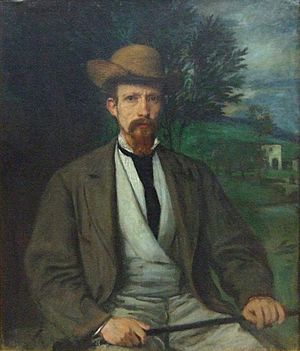Hans von Marées facts for kids
Hans von Marées (born December 24, 1837 – died June 5, 1887) was an important German painter. He first focused on painting people's faces, called portraits. Later, he started painting scenes from old myths and legends. Hans von Marées spent the end of his life living in Italy.
Contents
Life and Art of Hans von Marées
Early Life and Education
Hans von Marées was born into a banking family on December 24, 1837. His birthplace was Elberfeld, which is now part of Wuppertal, Germany. In 1847, his family moved to Koblenz. There, he went to a Gymnasium, which is a type of grammar school.
From 1853 to 1855, Marées studied art at the Prussian Academy of Arts in Berlin. In 1854, he joined the studio of Carl Steffeck. Steffeck was a painter and printmaker. Marées also served in the military from 1855 to 1857. After his military service, he moved to Munich. In Munich, he met another artist named Franz von Lenbach.
Developing His Art Style
While living in Munich, Marées mainly painted portraits. In 1864, a wealthy art collector, Count Adolf von Schack, sent Marées and Lenbach to Italy. Their job was to copy paintings by old master artists. In Italy, Marées became friends with Konrad Fiedler, an art expert. Fiedler later became a supporter of Marées's art. He also met the sculptor Adolf von Hildebrand.
In 1869, Marées traveled to France, the Netherlands, and Spain with Fiedler. He served in the military again during the Franco-Prussian War (1870–1871). After the war, he lived in Berlin and Dresden for a short time.
Murals in Naples and Later Works
In 1873, Marées painted murals on the library walls of the Stazione Zoologica in Naples, Italy. This was a new German Marine Zoological Institute. The murals show five scenes of people in landscapes. They are surrounded by decorative frames designed by Hildebrand. Marées wanted these paintings to show "the joys of sea and beach life."
The next year, he moved to Florence. There, he met Anselm Feuerbach and Arnold Böcklin. These artists were part of a group called the "German Romans." They believed in an ideal, intellectual style of art.
Marées started painting more scenes from myths and legends. He developed a special way of painting. He would paint with tempera, then add layers of oil paint. This created deep, rich colors. Art experts like Fritz Novotny said Marées gave a "completely new role" to color in his classic style.
Later Life and Legacy
In the 1880s, Marées painted four large artworks called triptychs. A triptych is a painting made of three panels. These works included The Judgment of Paris and The Hesperides. He also made smaller mythological paintings and some portraits.
Marées spent his last years in Rome, supported by Konrad Fiedler. He passed away in Rome in 1887 at the age of 49. He was buried in the Protestant Cemetery, Rome.
One of his paintings, Die Labung, was taken during the Nazi era in 1935. In 1980, it came into the collection of the Museum Wiesbaden. To help return art taken during that time, the museum showed only the back of the painting. They did this until they raised enough money to buy it and return it to its rightful owners later that year.
Images for kids
See also
 In Spanish: Hans von Marées para niños
In Spanish: Hans von Marées para niños



